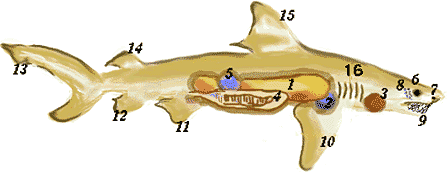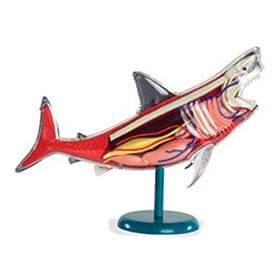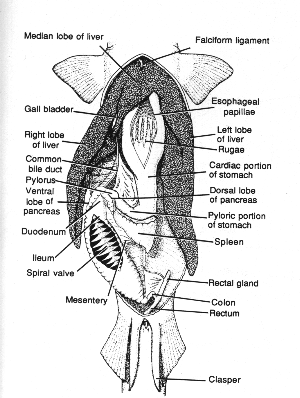
Shark Anatomy
| 1.Liver 2.Spiral valve 3.Heart 4.Pancreas | 5.Stomach 6.Eye 7.Nostril 8.Ampullae of Lorenzini | 9.Teeth 10.Pectoral Fin 11.Pelvic Fin 12.Anal Fin | 13.Caudal or Tail Fin 14.Second Dorsal Fin 15.First Dorsal Fin 16.Gills |
Skeleton
The bones of a fish are made mostly of calcium, but a shark doesn't really have any bones. A shark skeleton is made of cartilage. Bony fish have a gas-filled swim bladder which enables them to float in the water, but sharks have no such bladder. Since cartilage is lighter than bone, it helps to keep a shark from just sinking to the bottom of the ocean. A shark doesn't have as many moveable parts as a bony fish, which in some ways makes a shark a little more clumsy. But cartilage is more flexible than bone, so a shark can turn around in a smaller space than a bony fish. Sharks keep growing cartilage as long as they live, and have extra mineral deposits in their jaws where they need extra strength, (the better to bite you with).
Shape
When engineers came up with the shape of a DC-9 airplane, they were thinking about the fastest way to travel using the least amount of energy. If you compare the DC-9 to a shark, you will see that their shapes are amazingly similar. They both have round bodies tapering off at both ends. This shape allows the plane to glide through the air, and the shark to glide through the water, without using up all their fuel before they get where they want to go.
Coloration
Sharks are generally a dark color on top, which is called their dorsal side, and a light color on the bottom, which is called their ventral side. Predators looking down might not see the dark top of the countershaded shark, because it blends in with the dark ocean depths. But if a predator looks up from below, the light bottom of the shark blends in with the lighter surface of the sea where the sun shines. Either way, the shark manages very well to blend in with its environment and avoid being seen when it doesn't want to be seen.
Coloration
Sharks are generally a dark color on top, which is called their dorsal side, and a light color on the bottom, which is called their ventral side. Predators looking down might not see the dark top of the countershaded shark, because it blends in with the dark ocean depths. But if a predator looks up from below, the light bottom of the shark blends in with the lighter surface of the sea where the sun shines. Either way, the shark manages very well to blend in with its environment and avoid being seen when it doesn't want to be seen.
Nostrils
Sharks do have noses, but they only use them for smelling, not for breathing. You'll find their pair of nostrils on the underside of their snouts. Some species, like the Nurse Shark, even have some extra smellers called nasal barbels, which stick out near the nostrils and mouth.
Ampullae of Lorenzini
These are electroreceptive organs. The ampullae are jelly-filled pores shaped like ampullae (clay jars used by the Romans and others to store grain, oil, and wine). The function of these organs was not discovered until fairly recently. They are electr ical field sensing devices, and as everything living produces an electrical field, the shark can detect the presence of another living creature even if all its other senses were deactivated. The ampullae are distributed around the head, and the external openings and are large enough to be seen with the naked eye.
Gills
Tweet
Gills
Sharks have five to seven gill slits on each side of their head, unlike bony fish which have one gill on each side. As water passes over their gills, oxygen is absorbed by the blood in the gills and transported from there to the rest of the body.
Some sharks have small openings called spiracles behind their eyes, at the top of the head. Spiracles are sort of like baby gill slits. The more active, fast swimming sharks seem to have outgrown the need for these spiracles, and only have very t iny ones or don't have them at all.



Some sharks have small openings called spiracles behind their eyes, at the top of the head. Spiracles are sort of like baby gill slits. The more active, fast swimming sharks seem to have outgrown the need for these spiracles, and only have very t iny ones or don't have them at all.















Shark Anatomy

No comments:
Post a Comment
Dear Visitor,
Please feel free to give your comment. Which picture is the best?
Thanks for your comment.